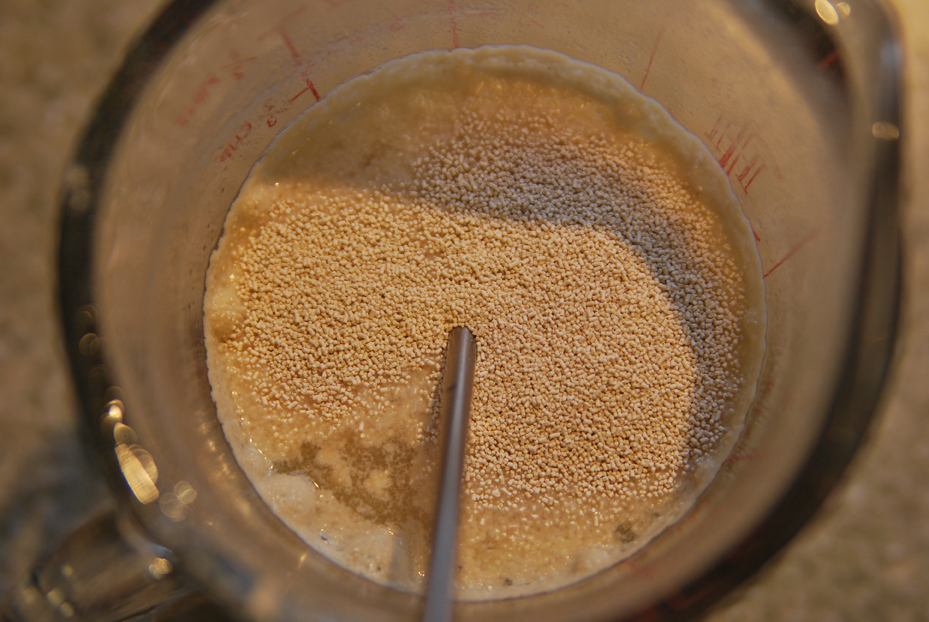Forward
There are many, many great meads out there for you to buy and drink at your leisure, but there is nothing quite like making mead in your own home and the pride that goes with it. And because mead is so simple at its core—it’s essentially just honey, water, and yeast—it is perfectly suited to being made at home.
But beware....
Just because the ingredients are simple, it doesn’t mean that making a good mead is simple too. We don’t recommend that you just throw a few pounds of honey in a bucket with some water and yeast and hope for the best. Sure, you’ll probably end up with something mead-ish at the end of the day, but our Viking ancestors would want us to aim a little higher.
In our epic guide, we’ll show you how to make a homemade mead that is not only better than mead-ish, but is something that you’ll actually be proud of, one that you wouldn't mind sharing with your loved ones (assuming you don’t keep it all to yourself). This guide also includes tips from the pros that will help make your first time a success, and will keep you coming back for more.
The Ingredients
Mead is as varied as the styles of Viking helmets. Beyond traditional meads (aka "Show Meads"), there are sack meads, cysers, pyments, melomels, metheglins, braggots, and many more - more than 50+ at last count!
This guide will cover the process for making with a solid traditional mead, meaning just honey and water with no fruit or spice additives. We will also stick with a middle of the road in terms of sweetness — neither too dry nor too sweet.
To make a standard five gallon batch of traditional mead (which yields about 25 standard wine bottles) here are the ingredients you will need to gather:
- 14 pounds of honey (about 2.8 pounds per gallon). There are numerous different varieties of honey out there—from basic clover, to orange blossom, to blueberry blossom, and more—each of which will impart its own distinct flavors into the mead. Since we're aiming for a semi-sweet, traditional mead you'll ideally want to use darker, more robust honey like Orange Blossom. The reason? Darker honeys tend to enhance the complexity of traditional, unflavored meads that lighter honeys can't quite match. There's a cost associated with premium honeys like Orange Blossom, so if the budget is being stretched, don't feel bad about opting for the more reasonably priced clove or wildflower varieties, Either way, your mead will turn out just fine.
- 4 gallons of spring water. Spring or mineral water from your local grocery store is preferable, or you can use water straight from your tap if it’s of good quality. If you use water from the tap, be sure to boil it first to make sure to get rid of any bacteria that may be hiding out.
- 2 packets of mead or wine yeast. There are hundreds of strains of yeast available for mead makers, but for a solid traditional mead our goto option is Lavin D-47. It's a hardy strain that ferments over a wide range of temperatures and produces semi-sweet to sweet mead around 14% ABV. Also, you will find that there are dry yeasts and liquid yeasts, each with their own advantages and disadvantages. Dry yeast packets usually have a longer shelf life, but require a little more effort to prepare, while liquid yeast packets usually have a shorter shelf life and need to be kept refrigerated prior to use. For this guide, we recommend acquiring 2 packets of dry Lavin D-47 yeast.
- 5 tsp of yeast nutrient. Although honey is loaded with sugar, it lacks the nitrogen and nutrients needed for yeast to multiple and thrive. In order to keep our single-celled powerhouses happy throughout the arduous fermentation period, we'll need to add a little sumpin' to help them along. While there's all sorts of nutrient options and protocols out there, we are going to keep things nice and simple. Since this is your first batch of mead, we recommend you purchase Fermaid-O to cover this bit. It's an organic nutrient complex that has just the right amount of nitrogen, ammino-acids, and micro-goodies to produce terrific tasting mead.
- 2.5 tsp of yeast energizer. Not to be confused with yeast nutrient, yeast energizer is important to add during the first tender moments of the fermentation process. While yeast energizers can contain essential nutrients like DAP (diammonium phosphate), it's real use is providing necessary bases to bring the PH levels up to a comfortable range for your yeast, while also giving the yeast a short-term energy boost to kick-start the fermentation process, You can find yeast energizer pretty cheap at your local home brew store, or online. Here's the yeast energizer we use.
The Equipment
Before you get started mixing your ingredients together, you will also need to gather some necessary equipment. Most of the equipment listed below can be found at your local home-brewing store (if you’re lucky enough to live near one), or at your local hardware store. Or if you have trouble finding something, you can always order it online, or through the links on our guide (FYI - we do collect a small referral fee from Amazon if you purchase through these links. We've used everything we recommend and the purchase will be at no cost to you.)
To reiterate: everything listed is assuming a 5-gallon batch of mead...
6.5 gallon mixing bucket and lid. While you can find these anywhere, the best mixing buckets are the graduated variety, meaning they have markings showing gallon and half gallon fill levels. Note: The lid comes pre-drilled and with a grommet/seal to accommodate the air-lock valve, just in case you ever want to use the bucket as a fermenting vessel. | |||
Five gallon glass carboys (Qty. 2). We recommend getting (2) 5-gallon carboys for this guide. You can get away with doing the primary fermentation in your mixing bucket, but we prefer actually seeing what's going on in our primary vessel, Plus it makes it much easier to introduce necessary oxygen into the must when transferring the must from your bucket to your carboy. | |||
Carboy handle. This handy little device connects around the top of your glass carboy and gives you a way to get a firm grip on your carboy so you can move it. It’s a big help when dealing with a full carboy, which can weigh upwards of 50 to 55 pounds. | |||
Fermentation lock / Air lock. These fit in the top of your glass carboy and allow carbon dioxide to escape from your carboy while preventing bacteria from coming in. They make a couple of different varieties. We think the 3 piece is a bit more robust, and easier to keep clean. | |||
Rubber Stoppers. The bungs will fit into the tops of your carboy to fit your air lock, helping to get the seal airtight. 6.5 gallon carboys take a #6.5 Stopper size, make sure yours is pre-drilled to fit your fermentation lock (some airlocks come with the stoppers included). | |||
Mixing spoon / paddle. Any type of mixing instrument will do here, although authentic Viking ship oars and axes tend to result in the best flavors. | |||
Funnel. You'll need a funnel to transfer liquids between the mixing bucket and the glass carboy. Get a big one! | |||
Hydrometer. This handy gadget looks like a floating thermometer, but instead of measuring temperature it measures how much sugar is dissolved in the must. The amount of dissolved sugar can in turn be used to determine the alcohol content of your mead (more on this below). Most hydrometers designed for wine making or brewing will include three different scales: original gravity, Balling, and Brix. Each of these scales measures the same thing (dissolved sugar), albeit with different numbers. We use specific gravity here, and most hydrometers will show specific gravity readings from around 0.990 to around 1.160. | |||
Thermometer. Any liquid-compatible thermometer will do here. You will be taking the temperature of the honey-water mix to calibrate your specific gravity readings, and to make sure the its within the temperature range that your yeast can handle before you pitch it. | |||
Sanitizing solution. There are many great food-grade sanitizers out there for you to choose from, although we typically recommend Star San, which is a no-rinse acid-based sanitizer. 1 ounce treats 5 gallons of water, | |||
Wine bottles. These are easy to come by. We like to use clear bottles, since they tend to show off the color the mead. You will need about 25 standard 750 mL wine bottles for your five-gallon batch (about five 750 mL bottles per gallon). | |||
Auto-filler. This name of this device makes it sound more complicated than it is. An auto filler hooks onto the other end of your plastic tubing and has a device on the end that is either spring- or gravity-activated and helps control the flow of liquid and make bottle filling easier. | |||
Corks. There are several different types of corks, which vary based on diameters and length. For our purposes, you'll want to get straight corks. As a rule of thumb, the thicker and longer the cork, the longer your mead will last. We recommend that you use a #9 x 1-1/2" to 1-3/4” cork, which is more than sufficient to keep your mead for more than 18 months. Pro Tip "Make sure you buy more corks than you need for your batch. During the corking process you can expect a few of the corks to fail to go into the bottle property, so you’ll want some extra corks on hand." | |||
Corker. These come in hand-held, table-top, and floor-mounted versions (in increasing order of expense). Although they're a bit more expensive and tend to take up more space, a floor corker is generally worth it if you can get away with it. They keep your bottles much more stable during the corking process, especially for longer and thicker corks. | |||
 | Pen and notebook. One of the most important items on this list, and easily overlooked! You will definitely want to keep a log for your mead so that you can help your future self with any tips and tricks (and things to avoid!) for when you make your next batch of mead. Your log will also serve as a helpful reminder for how each step went and as a record of any readings that you took during the mead-making process. | ||
Preparing The Must
Now that you have your ingredients and equipment, the first step in making your own mead is to prepare the “must” (the mixture of honey and water), and to add the yeast to your must—a process called “pitching.” After that, the yeast will slowly turn the must into liquid gold over the course of several weeks.
You will want to give yourself plenty of time (at least a couple of hours) for this initial step in the mead-making process. Most of that time will be getting the yeast ready and making sure that everything is clean and sanitized before you start mixing.
For this step, you’ll need all your ingredients and the following equipment & ingredients:
- 14 lbs of honey
- 2 X D-47 Lavin dry yeast packets
- Mixing bucket
- One glass carboys
- Fermentation lock / air lock
- Large mixing spoon
- Funnel
- Hydrometer
- Thermometer
- Sanitizing solution.
- Paper towels

The Engineer
Pro Tip: Warm your honey
"Before you do anything, fill your sink or a pot with hot water from your faucet and place your honey (still in the containers) in the hot water. As the honey warms up, it will flow better, thereby making it easier for you to get the honey out of its container and into the mixing bucket."
Once you’ve gathered up the supplies, here’s what you’ll need to do.
- Rehydrate The Yeast. Prepare the yeast according to the instructions on the yeast packet. For our Lavin D-47, this means rehydrating the yeast by adding the contents of your 2 dry yeast packets to pre-boiled water in a glass pouring cup. Make sure that the water has cooled to between 104 – 109 degrees F. Mix in with a sanitized kitchen spoon and letting the mixture sit for at least 15 minutes.

Rehydrating The Yeast For Making Mead
- Sanitize Equipment and Surfaces. While the honey is warming, and the yeast is getting set up, prepare a sanitizing solution and sanitize all of the equipment and all the surfaces that you’ll be working on. This is a crucial step, and will help to ensure that the fermentation process is being driven by the yeast, and not by some other bacteria that was inadvertently introduced to the must.
- Fill Bucket With 4 Gallons of Water. While your yeast is waking up, add the four gallons of water to the mixing bucket. If your bucket is graduated, you can measure this using the graduated scale on the bucket side.
- Stir Honey In The Water. Next, stir the honey into the water, mixing everything with all the vigor of a Viking preparing for battle. Not only will this ensure that the honey is adequate mixed into the water, but it will also make sure that you introduce enough oxygen into the must for the yeast to multiply and thrive. The more mixing, the better.
- Top Off With Water. Top off the bucket with more water to make 5 gallons total

Checking The Calibration On Your Hydrometer
If you haven’t already, now would be a good time to make sure your hydrometer is properly calibrated and providing correct readings. Hydrometers are calibrated to be used at a particular temperature, usually 68 °F/20 °C.
In pure water at the calibration temperature, your hydrometer should give a specific gravity reading of 1.000. If the temperature of the liquid is higher or lower you will need to apply a quick conversion to the specific gravity reading of your hydrometer (adjusting the reading higher if the temperature is higher, and lower if the temperature lower). Your hydrometer should come with a conversion chart; otherwise there are plenty of online tables you can use to convert your reading according to the temperature.
To check the calibration of your hydrometer, first use your thermometer to check the temperature of the water, and make note of the temperature in your notebook. Then simply drop the hydrometer in the water and check the specific gravity reading at the water level (you may want to give the hydrometer a quick spin to shake off any bubbles that might throw off your reading).
Make any necessary conversions based on temperature and then jot this information down in your notebook—if there’s any deviation then you’ll want to add/subtract the amount to future specific gravity readings.
- Take Must Temperature and Specific Gravity Readings. With the must fully mixed, you’ll need to take the temperature of your mead to (1) Ensure that it is within the temperature range for adding you yeast, and (2) To take the specific gravity reading. Using your hydrometer, measure the specific gravity and then make any conversions to your reading based on the temperature. Be sure to record this specific gravity reading, which is called the “original gravity” reading, in your log book since it will be used to determine the ultimate alcohol content of your mead. Depending on the sugar content of your honey, the original gravity reading should be between 1.100 and 1.110. (If it’s a little off of this range, don’t worry about it. Just record the initial number and move on.)
- Pitch Your Yeast. If 15 minutes have transpired, pitch the yeast into the must so that the magic can start to happen. Add the yeast and the yeast nutrient (in your case Fermaid O), to the mixing bucket and give the must another vigorous couple minutes of stirring with your sanitized spoon.
- Transfer Must To 1st Carboy. Next, harnessing all the strength of Odin, transfer the must from the mixing bucket to one of the glass carboys using the funnel. All the splashing and agitation from the transfer will help add additional oxygen to the must. (Note: if it is too much effort for a mere mortal such as yourself to transfer the must to the glass carboy by lifting the mixing bucket, you can always start by siphoning most of it into the carboy using your plastic tubing—only after sanitizing the plastic tubing, of course!—and then tip the mixing bucket into the funnel to get the last remaining liquid transferred to the carboy). If there’s room, you can top off the carboy up to the neck (where the top of the carboy starts to curve inward) with remaining clean water.
- Clean Up. Using your paper towels, wipe off any must that may have spilled onto the outside of the carboy. This will help to avoid providing a foothold for any bacteria to grow around your precious must.
- Move Carboy To A Cool Location. Attach your carboy handle to the carboy, then insert the air lock to the top of the carboy (you don’t need to fill the air lock at this point – it’s inserted just to avoid spills as you move the carboy). Next, by the power of Thor’s hammer, muscle your carboy to a cool, dry area where it can sit undisturbed by pets, kids, and spouses. Good locations typically include basements and closets.
- Fill Airlock With Water. Once your carboy is settled into it’s new home, prepare the air lock by adding water up to the fill line. The air lock is now ready to protect your mead from airborne contaminants.

The Viking
Pro Tip: Clean up
"Before you crack open a cold one and kick back to relax, be sure to rinse and clean all the equipment you used – your future-self will thank you. Trust us, there’s nothing fun about trying to scrape month-old or year-old honey residue from your valuable equipment."
That’s it for now! Within 18 to 24 hours you should start to see activity in your carboy as the yeast multiply and begin to convert sugar into alcohol. After 48 hours, the air lock should be bubbling every 2 to 3 seconds, indicating the fermentation process is underway and is transforming your must into a delicious mead.
We recommend checking on your mead every day or two and noting the current status of the yeast activity (e.g., 1 bubble every 2 seconds) or changes in the color of the mead. This log will help you to understand what to expect and when in future batches, and will also alert you to any possible issues (such as a stuck fermentation process).
Fermentation and Racking
After around 3 weeks, the primary fermentation process will slow down in the carboy. This slow down will be marked by a reduction in the speed of bubbles appearing in the air lock to about 1 bubble every 30 seconds or so. You will also notice that the mead in the upper part of the carboy is a lighter color than the bottom part, as the yeast and any particulates in the mead start to settle at bottom of the carboy.
At this point, you will need to transfer the must off the sediment that has collected at the bottom carboy, since the sediment includes dead and dormant yeast cells and other particles that could start to impart undesired flavors if left in contact with the must. Unlike the first step in the mead-making process, during the racking process you’ll want to keep any agitation of the must to a minimum in order to avoid adding any more oxygen into the must.
For this step, you’ll need the following equipment:
- The second carboy
- The racking cane and plastic tubing
- Hydrometer
- Thermometer
- Sanitizing solution.
- Air Lock, and pre-drilled stopper
With the equipment ready for use, follow the steps below to transfer your must into the second carboy so it can continue its secondary fermentation:
- Sanitize Your Equipment. Sanitize the second carboy, the racking cane and the plastic tubing, along with any surfaces you’ll be working on. Set aside some of the sanitizing solution to clean the air lock after the must has been transferred to the new carboy.
- Elevate the Primary Carboy. Heave-ho the first carboy (the one with the must in it) up onto a shelf or counter so that the bottom of the first carboy is above the top of the second carboy. This difference in height will allow gravity to drive the siphon and transfer the must into its new home.
- Route The Racking Cane and Tubing. Attach the plastic tubing to the short end of the racking cane, and then insert the long end of the racking cane into the first carboy.

The Thinker
Pro Tip: Stir the sediment
"Before you start to rack your mead, use the racking cane to give the must a good, but slow, circular stir until the must starts to rotate, wait for it to settle again and start the transfer —this action will help to move sediment to the edges of the bottom of the carboy and will create a relatively sediment-free zone in the middle."
- Position The Racking Cane. Position the racking cane in the middle of the first carboy, several inches off of the bottom in order to avoid pulling sediment into the second carboy.
- Start Siphon And Crimp Hose. Start a siphon on the other end of the plastic tubing—you can use your mouth to start the siphon, but be sure to take a swig of mouthwash (or your favorite hard liquor) to sanitize your mouth first. Once the siphon has been started, crimp the tubing — don’t start transferring must into the second carboy just yet!
- Take Specific Gravity Reading. It’s time to take another specific gravity reading to see how much fermentation has progressed. Unlike your original gravity reading, you won’t be dropping your hydrometer into the must itself. Instead, siphon a small amount of must into a separate container—ideally the plastic tubing that came with your hydrometer. Then drop the hydrometer into this separate container, give it a spin to knock off any bubbles, and record your reading. Make any adjustments to this specific gravity reading based on the temperature of the must, and record the result in your log book. At this point your reading should be less than 1.030, and ideally between 1.015 and 1.025.
- Start The Transfer. Next, insert the free end of the plastic tube all the way into the second carboy until its resting on the bottom of the second carboy, against the side *IMPORTANT*. Positioning the plastic tube in this manner will help to avoid splashing the must as it is transferred. Then realize the crimp in the tubing and let the must transfer into the second carboy. Continue transferring must into the second carboy until you see sediment being pulled up by the siphon, at which point you should stop the siphon.
- Top Off With Water. Gently top off the must in the second carboy with a small amount of spring water or sanitized tap water, at least to the neck of the carboy. This will help eliminate any remaining head space and force out unwanted oxygen (although a majority of the oxygen will be forced out by carbon dioxide produced by the remaining yeast in the must).
- Insert Air Lock. If you’re reusing the air lock on your first carboy, sanitize it and the stopper thoroughly and insert them on top of your second carboy.
- Clean Up. Rinse and thoroughly clean the first carboy, racking cane, and tubing. Again, your future-self will thank you.
Now that the must has been transferred off the sediment from the first carboy, it can wrap up any residual fermentation and then rest and clear in peace.
Congratulations, you're finished for now. Take a deep breath, and compose yourself.
Bottling
After another week or two, any yeast activity should cease altogether. And after another month the must should become clear. Now that the yeast has done its work and the must (now mead, really) is completely clear, it is ready for bottling.
Note that if the must is still active and cloudy at this point, or if you find another thick layer of sediment growing on the bottom of the carboy, you will want to repeat Step 2 and re-rack the must to further aid in clarification.
For the bottling step you will need the following equipment: Racking cane and plastic tubing, wine bottles, auto-filler, corks, corker, hydrometer, thermometer, and sanitizing solution. Now here’s what you’ll have to do for the final step in your mead-making process:
For the racking steps you’ll need the following equipment:
- Racking cane and plastic tubing
- Wine bottles
- Auto-filler
- Hydrometer
- Thermometer
Once again, sanitize everything that will be coming in contact with the mead, including any surfaces you’ll be working on.

The Engineer
Pro Tip: Sanitize them bottles!
"A quick and easy way to sanitize and dry a large batch of wine bottles at once (assuming they’ve already been rinsed thoroughly beforehand) is to just run them through your dishwasher on the rinse and dry setting with no detergent added."
- Prepare Your Corks. Breaking a bottle during the corking process sucks! So in order to make the corking process easier, we recommend adding some moisture to your dry corks by steaming them
- Stir The Sediment. Just like in the racking process, give the mead a slow, circular stir to help move any sediment to the edges of the carboy.
- Route The Racking Cane And Tubing. Connect the racking cane to one end of your plastic tubing. Then insert the racking cane into the clear mead.
- Siphon and Pinch. With the racking cane a few inches off of the bottom, start a siphon and then pinch off the tubing while you attach the auto-filler to the other end of the plastic tubing.
- Take Specific Gravity Reading. Before you start bottling, you will want to take one last specific gravity reading so you can determine the alcohol content of your mead. This last specific gravity reading will be the final gravity (FG) of your mead.
- Insert Auto Filler. Insert the auto-filler into each bottle and press it against the bottom of the bottle. Fill each bottle up to about 2 inches from the top of each bottle. Continue filling bottles until the siphon starts pulling up sediment from the carboy.
Corking Your Bottles
After the bottles have been filled, use your corker to insert the corks into each bottle. This is often the toughest part of the process, as forcing the cork into the bottle requires a good deal of strength and coordination. Hopefully it should be a quick, painless, and triumphant operation. However, unless you’ve the strength of Odin, you can’t just plunge the cork into your bottle with your thumb. Corking your mead takes a little mechanical assistance, which you’ll get in the form a corker.
While there’s a bunch of styles of corker on the market today, they all fit into two main categories; hand corkers and floor / bench corkers. Let’s take a look at each:
Hand Corkers:
Hand corkers are going to be less expensive than floor corkers, and take a little more finesse, practice, and effort to use properly. Hand corkers are a good economical choice for the mead maker planning to produce less than 5 gallons (~25 bottles) of mead a year. They do take a bit to get used to, so don’t get frustrated if you end up with a couple of broken bottles or a cork sticking halfway in the neck while you learn the nuances of the tool.
Soaking Your Cork
Because of the limited torque that hand corkers provide, you’ll need to use some kind of lubrication to get the cork seated in the bottle correctly. This is especially true for the tighter #9 corks we recommend using.
For this, we take notes from mead-maestro Ken Schramm, author of the seminal mead book “The Compleat Mead Maker” who recommends soaking your corks in a gallon of water treated with 2 campdem tablets and a few drops of food-grade Glycerin.
Check out our article on Corking Your Mead for tips and tricks on stopping up your bottle with cork.

The Viking
Pro Tip: Corking stabilization
"Nothing make me more angry than a broken bottle full of mead! If using a hand corker, you’ll find that one of the problems is keeping the bottle stable as you apply enough pressure to push the cork into the bottle. Often times, the bottle can slip out from under you, resulting in spills or, even worse, broken bottles. You can help stabilize the bottle by placing it in something with a little more grip – such as a beer koozie (or barring that, even a sneaker will do the trick.."
Store your mead upright for the first two weeks to allow any moisture from your corks to evaporate out. After that, store your mead on its side. This will keep the seal nice and tight during aging.
Your mead is now ready to enjoy!
For your first batch, we recommend sampling a bottle every couple of months to see how the flavor mellows and changes over time.
Fin
Guess what? You've come to the end of our mead making guide which means...You...are...done! Hooray for YOU!
Now go forth to enjoy and share the fruits of your labor.
Hopefully this provided some help on you're journey into your enjoyment of mead. Feel free to comment or send us a note if you have any questions - we would be happy to respond...
Sincerely,
The Men Of Mead
No reviews yet...


















